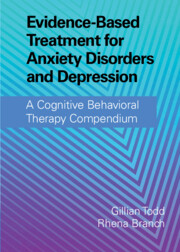 Evidence-Based Treatment for Anxiety Disorders and Depression
Evidence-Based Treatment for Anxiety Disorders and Depression Book contents
- Evidence-Based Treatment for Anxiety Disorders and Depression
- Evidence-Based Treatment for Anxiety Disorders and Depression
- Copyright page
- Contents
- Figures
- Tables
- Contributors
- 1 Introduction
- 2 The History and Philosophical Underpinnings of CBT:
- Part One Cognitive Behavioral Therapy for Anxiety Disorders
- 3 CBT for Specific Phobias
- 4 CBT for Panic Disorder
- 5 The Cognitive Behavioral Treatment of Agoraphobia
- 6 Cognitive Behavioral Therapy for Social Anxiety Disorder
- 7 CBT for Social Anxiety Disorder
- 8 CBT for Somatic Symptom Disorder and Illness Anxiety Disorder
- 9 Cognitive Behavioral Therapy for Generalized Anxiety Disorder:
- Part Two Cognitive Behavioral Therapy for Posttraumatic Stress Disorder
- Part Three Cognitive Behavioral Therapy for Obsessive-Compulsive Disorder and Associated Disorders
- Part Four Cognitive Behavioral Therapy for Depression
- Part Five Complexity and Comorbidity in Anxiety Disorders and Depression:
- Part Six Specialist Applications of Cognitive Behavioral Therapy for Anxiety Disorders and Depression
- Part Seven Future Developments
- Appendices
- Index
- References
5 - The Cognitive Behavioral Treatment of Agoraphobia
from Part One - Cognitive Behavioral Therapy for Anxiety Disorders
Published online by Cambridge University Press: 06 January 2022
- Evidence-Based Treatment for Anxiety Disorders and Depression
- Evidence-Based Treatment for Anxiety Disorders and Depression
- Copyright page
- Contents
- Figures
- Tables
- Contributors
- 1 Introduction
- 2 The History and Philosophical Underpinnings of CBT:
- Part One Cognitive Behavioral Therapy for Anxiety Disorders
- 3 CBT for Specific Phobias
- 4 CBT for Panic Disorder
- 5 The Cognitive Behavioral Treatment of Agoraphobia
- 6 Cognitive Behavioral Therapy for Social Anxiety Disorder
- 7 CBT for Social Anxiety Disorder
- 8 CBT for Somatic Symptom Disorder and Illness Anxiety Disorder
- 9 Cognitive Behavioral Therapy for Generalized Anxiety Disorder:
- Part Two Cognitive Behavioral Therapy for Posttraumatic Stress Disorder
- Part Three Cognitive Behavioral Therapy for Obsessive-Compulsive Disorder and Associated Disorders
- Part Four Cognitive Behavioral Therapy for Depression
- Part Five Complexity and Comorbidity in Anxiety Disorders and Depression:
- Part Six Specialist Applications of Cognitive Behavioral Therapy for Anxiety Disorders and Depression
- Part Seven Future Developments
- Appendices
- Index
- References
Summary
Agoraphobia is characterized by the avoidance of places such as shopping centers, bridges, tunnels, and crowds due to fear of experiencing intense and often debilitating anxiety symptoms and is commonly diagnosed in young to middle-aged adults and women. When entrenched, agoraphobia imposes severe restrictions on the person’s capacity to venture out of the home. Evidence supports the use of CBT in treating the disorder. Key elements of intervention include psychoeducation, cognitive restructuring, breathing retraining to curtail panic symptoms, strategies to reduce general physical symptoms of anxiety, exposure to interoceptive anxiety-provoking stimuli, and, crucially, gradual in vivo exposure to overcome avoidance. Medications, particularly the SSRI class of drugs, may add to the effects of CBT in some patients. Sole treatment with SSRIs may be necessary where patients are unable or unwilling to pursue CBT. Treatment outcomes are more favorable when a management plan is developed collaboratively with a motivated patient and with partners and family involved in treatment. Booster CBT sessions may improve treatment outcomes. Recent developments include online programs, apps, and virtual reality platforms to facilitate exposure to anxiety-provoking situations within a CBT framework. Alternative forms of psychotherapy should be considered if CBT has little impact.
Keywords
- Type
- Chapter
- Information
- Evidence-Based Treatment for Anxiety Disorders and DepressionA Cognitive Behavioral Therapy Compendium, pp. 75 - 92Publisher: Cambridge University PressPrint publication year: 2022


